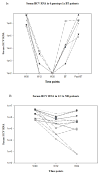Evolution of hepatitis C virus NS5A region in breakthrough patients during pegylated interferon and ribavirin therapy*
- PMID: 19656286
- PMCID: PMC3189487
- DOI: 10.1111/j.1365-2893.2009.01169.x
Evolution of hepatitis C virus NS5A region in breakthrough patients during pegylated interferon and ribavirin therapy*
Abstract
Investigating the evolution of the hepatitis C viral (HCV) genome in the small number of patients that experience viral breakthrough might shed light on the problem of resistance to interferon therapy. Within the HCV genome, sequence diversity of the viral nonstructural 5A protein-coding region (NS5A) has been linked to interferon responsiveness. We analysed the temporal sequence changes within NS5A in genotype 1a patients: 6 breakthrough (BT), 12 sustained virologic responders (SVR) and 12 non-responders (NR), all of whom had received full dose peg-interferon and ribavirin therapy. The entire NS5A region was amplified by reverse transcription (RT)-PCR followed by direct sequencing of serum samples from baseline and three on-treatment time points for each group. Comparing baseline sequences with week 12 and later time points, BT patients resembled SVR patients in having a higher number of amino acid substitutions at week 12 than NR patients; however, the number of amino acid substitutions in this group decreased at and after BT. Substitutions were focused in the V3 and flanking regions in BT patients but not in SVR patients. The high number of substitutions in NS5A in both BT and SVR groups suggests that selective pressure is associated with viral response to therapy. Our results provide evidence that amino acid substitutions within the NS5A coding region may reflect a host response that drives selective pressure for viral adaptation.
Figures






Similar articles
-
Quasispecies of hepatitis C virus genotype 1 and treatment outcome with peginterferon and ribavirin.Infect Genet Evol. 2009 Jul;9(4):689-98. doi: 10.1016/j.meegid.2008.11.001. Epub 2008 Nov 21. Infect Genet Evol. 2009. PMID: 19063998
-
Mutations in the NS5A gene of hepatitis C virus subtype 1b and response to peg-IFNα-2a/RBV combination therapy in Azerbaijani patients.Arch Virol. 2014 Nov;159(11):2893-9. doi: 10.1007/s00705-014-2133-0. Epub 2014 Aug 20. Arch Virol. 2014. PMID: 25139545
-
Impact of NS5A sequences of Hepatitis C virus genotype 1a on early viral kinetics during treatment with peginterferon- alpha 2a plus ribavirin.J Infect Dis. 2007 Oct 1;196(7):998-1005. doi: 10.1086/521306. Epub 2007 Aug 21. J Infect Dis. 2007. PMID: 17763320 Clinical Trial.
-
Efficacy of daclatasvir in hepatitis C virus.Expert Rev Anti Infect Ther. 2014 Sep;12(9):1025-31. doi: 10.1586/14787210.2014.942282. Epub 2014 Jul 25. Expert Rev Anti Infect Ther. 2014. PMID: 25059552 Review.
-
Treatment of hepatitis C virus genotype 3-infection.Liver Int. 2014 Feb;34 Suppl 1:18-23. doi: 10.1111/liv.12405. Liver Int. 2014. PMID: 24373074 Review.
Cited by
-
NS5A sequence heterogeneity of hepatitis C virus genotype 4a predicts clinical outcome of pegylated-interferon-ribavirin therapy in Egyptian patients.J Clin Microbiol. 2012 Dec;50(12):3886-92. doi: 10.1128/JCM.02109-12. Epub 2012 Sep 19. J Clin Microbiol. 2012. PMID: 22993188 Free PMC article.
-
Coevolution of the hepatitis C virus polyprotein sites in patients on combined pegylated interferon and ribavirin therapy.J Virol. 2011 Apr;85(7):3649-63. doi: 10.1128/JVI.02197-10. Epub 2011 Jan 19. J Virol. 2011. PMID: 21248044 Free PMC article.
-
Phylogenetic analysis of the 5' untranslated region of HCV from cirrhotic patients in Khyber Pakhtunkhwa, Pakistan.Sci Rep. 2021 Jul 22;11(1):15023. doi: 10.1038/s41598-021-94063-1. Sci Rep. 2021. PMID: 34294747 Free PMC article.
-
Impact of hepatitis C virus heterogeneity on interferon sensitivity: an overview.World J Gastroenterol. 2014 Jun 28;20(24):7555-69. doi: 10.3748/wjg.v20.i24.7555. World J Gastroenterol. 2014. PMID: 24976696 Free PMC article. Review.
-
Sequence heterogeneity in NS5A of hepatitis C virus genotypes 2a and 2b and clinical outcome of pegylated-interferon/ribavirin therapy.PLoS One. 2012;7(2):e30513. doi: 10.1371/journal.pone.0030513. Epub 2012 Feb 2. PLoS One. 2012. PMID: 22319571 Free PMC article.
References
-
- Fried MW, Shiffman ML, Reddy KR, et al. Peginterferon alfa-2a plus ribavirin for chronic hepatitis C virus infection. N Engl J Med. 2002;347(13):975–82. - PubMed
-
- Hadziyannis SJ, Sette H, Jr, Morgan TR, et al. Peginterferon-alpha2a and ribavirin combination therapy in chronic hepatitis C: a randomized study of treatment duration and ribavirin dose. Ann Intern Med. 2004;140(5):346–55. - PubMed
-
- Manns MP, McHutchison JG, Gordon SC, et al. Peginterferon alfa-2b plus ribavirin compared with interferon alfa-2b plus ribavirin for initial treatment of chronic hepatitis C: a randomised trial. Lancet. 2001;358(9286):958–65. - PubMed
-
- Yuan HJ, Lee WM. Nonresponse to treatment for hepatitis C: current management strategies. Drugs. 2008;68(1):27–42. - PubMed
-
- Enomoto N, Sakuma I, Asahina Y, et al. Mutations in the nonstructural protein 5A gene and response to interferon in patients with chronic hepatitis C virus 1b infection. N Engl J Med. 1996;334(2):77–81. - PubMed
Publication types
MeSH terms
Substances
Associated data
- Actions
- Actions
- Actions
- Actions
- Actions
- Actions
- Actions
- Actions
- Actions
- Actions
- Actions
- Actions
- Actions
- Actions
- Actions
- Actions
- Actions
- Actions
- Actions
- Actions
- Actions
- Actions
- Actions
- Actions
- Actions
- Actions
- Actions
- Actions
- Actions
- Actions
- Actions
- Actions
- Actions
- Actions
- Actions
- Actions
- Actions
- Actions
- Actions
- Actions
- Actions
- Actions
- Actions
- Actions
- Actions
- Actions
- Actions
- Actions
- Actions
- Actions
- Actions
- Actions
- Actions
- Actions
- Actions
- Actions
- Actions
- Actions
- Actions
- Actions
- Actions
- Actions
- Actions
- Actions
- Actions
- Actions
- Actions
- Actions
- Actions
- Actions
- Actions
- Actions
- Actions
- Actions
- Actions
- Actions
- Actions
- Actions
- Actions
- Actions
- Actions
- Actions
- Actions
- Actions
- Actions
- Actions
- Actions
- Actions
- Actions
- Actions
- Actions
- Actions
- Actions
- Actions
- Actions
- Actions
- Actions
- Actions
- Actions
- Actions
- Actions
- Actions
- Actions
- Actions
- Actions
- Actions
- Actions
Grants and funding
LinkOut - more resources
Full Text Sources
Medical
Molecular Biology Databases

